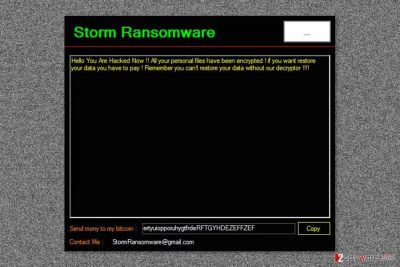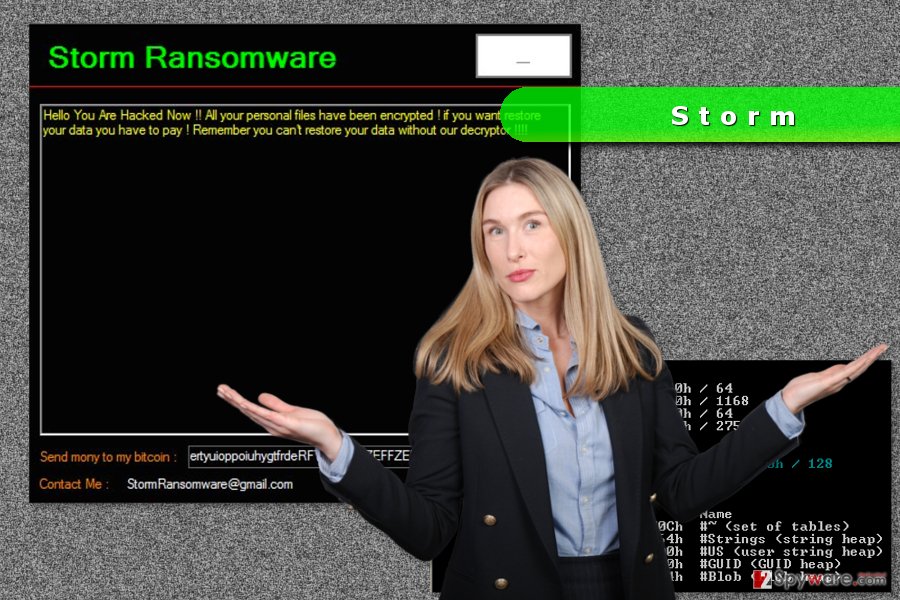Storm ransomware / virus (Decryption Methods Included) - Tutorial
Storm virus Removal Guide
What is Storm ransomware virus?
Storm – a poor example of ransomware virus

Storm ransomware is a file-encrypting virus that is created with .net compiler. After encrypting files, it demands to pay the ransom and provides contact email address StormRansomware@gmail.com. However, researchers say that this crypto-malware is not a huge threat.
Storm virus uses a hard coded password to lock files on the affected computer, so it should not be hard to guess it. Therefore, you should not be scared by the ransom note that tells that you need to pay for the decryptor. Third-party recovery software should be able to help you.
However, crooks made a terrible mistake. They provided an invalid Bitcoin address. Therefore, even if you would be one of those victims who would risk paying the ransom, you wouldn’t be able to do it. It goes without saying that after the attack, you should focus on Storm removal.
What is more, authors of Storm use Gmail email. Thus, this email might be blocked soon. Moreover, the identity of the hackers might be found as well. We believe that this ransomware is created by wannabe cyber criminals who lack programming skills and knowledge.
However, the virus mostly spreads with the help of malicious email attachments and once victim opens the obfuscated file, malware executable, which is based on Stub.exe, is downloaded on the system. It aims at the most popular file types, such as MS Office documents, pictures, databases and similar files.
Nevertheless, the virus is not a huge cyber threat; it might still affect numerous Windows OS processes. Therefore, you should not let it stay for a long on the system. Remove Storm ransomware using reputable malware removal tool, for instance FortectIntego.
If you cannot install or update your chosen security software, you should check the instructions at the end of the article. Sometimes file-encrypting viruses block access to antivirus or anti-malware. It doesn’t seem like Storm ransomware could do it, but in the case of emergency, you will know how to disable the virus and run automatic elimination.

The main ways how ransomware viruses spread
Cyber criminals might use several ways to spread malicious programs. The usage of several distribution strategies helps to attack more devices. However, you can avoid infiltration if you be aware of these methods and follow security tips.
- The main ways how crypto-malware spreads:
- spam emails and malicious content included to them (buttons, links, attachments),
- malvertising on legitimate and high-risk websites,
- fake or illegal downloads,
- exploit kits.[1]
The most popular method among cyber criminals is malspam. Hackers use social engineering tactics to trick users into clicking malicious content. Hence, you have always to double-check the information about the sender, look up for grammar mistakes and other suspicious details[2] before clicking links or opening documents.
Security experts from the NoVirus[3] note that downloading illegal or fake programs often lead to ransomware attacks too. So, you should stay away from insecure download sites. What is more, you should not visit high-risk websites and keep software updated.
Elimination instructions of the Storm virus
Nevertheless, this example of malware does not look like a real threat; you should still eliminate it properly. Storm removal has to performed using reputable malware removal program, for instance FortectIntego, SpyHunter 5Combo Cleaner or SpyHunter 5Combo Cleaner. Keep in mind that it might be impossible to locate and delete suspicious components from the system manually without causing more damage. Thus, choose the tool you trust, and scan the device!
If you cannot install security software, you can find the instructions how to disable the virus below. Once you remove Storm malware, you can check data recovery options or use backups.
Getting rid of Storm virus. Follow these steps
Manual removal using Safe Mode
If you cannot remove Storm automatically, you may need to disable the virus first. These instructions will help you:
Important! →
Manual removal guide might be too complicated for regular computer users. It requires advanced IT knowledge to be performed correctly (if vital system files are removed or damaged, it might result in full Windows compromise), and it also might take hours to complete. Therefore, we highly advise using the automatic method provided above instead.
Step 1. Access Safe Mode with Networking
Manual malware removal should be best performed in the Safe Mode environment.
Windows 7 / Vista / XP
- Click Start > Shutdown > Restart > OK.
- When your computer becomes active, start pressing F8 button (if that does not work, try F2, F12, Del, etc. – it all depends on your motherboard model) multiple times until you see the Advanced Boot Options window.
- Select Safe Mode with Networking from the list.

Windows 10 / Windows 8
- Right-click on Start button and select Settings.

- Scroll down to pick Update & Security.

- On the left side of the window, pick Recovery.
- Now scroll down to find Advanced Startup section.
- Click Restart now.

- Select Troubleshoot.

- Go to Advanced options.

- Select Startup Settings.

- Press Restart.
- Now press 5 or click 5) Enable Safe Mode with Networking.

Step 2. Shut down suspicious processes
Windows Task Manager is a useful tool that shows all the processes running in the background. If malware is running a process, you need to shut it down:
- Press Ctrl + Shift + Esc on your keyboard to open Windows Task Manager.
- Click on More details.

- Scroll down to Background processes section, and look for anything suspicious.
- Right-click and select Open file location.

- Go back to the process, right-click and pick End Task.

- Delete the contents of the malicious folder.
Step 3. Check program Startup
- Press Ctrl + Shift + Esc on your keyboard to open Windows Task Manager.
- Go to Startup tab.
- Right-click on the suspicious program and pick Disable.

Step 4. Delete virus files
Malware-related files can be found in various places within your computer. Here are instructions that could help you find them:
- Type in Disk Cleanup in Windows search and press Enter.

- Select the drive you want to clean (C: is your main drive by default and is likely to be the one that has malicious files in).
- Scroll through the Files to delete list and select the following:
Temporary Internet Files
Downloads
Recycle Bin
Temporary files - Pick Clean up system files.

- You can also look for other malicious files hidden in the following folders (type these entries in Windows Search and press Enter):
%AppData%
%LocalAppData%
%ProgramData%
%WinDir%
After you are finished, reboot the PC in normal mode.
Remove Storm using System Restore
It's another method to run automatic ransomware elimination.
-
Step 1: Reboot your computer to Safe Mode with Command Prompt
Windows 7 / Vista / XP- Click Start → Shutdown → Restart → OK.
- When your computer becomes active, start pressing F8 multiple times until you see the Advanced Boot Options window.
-
Select Command Prompt from the list

Windows 10 / Windows 8- Press the Power button at the Windows login screen. Now press and hold Shift, which is on your keyboard, and click Restart..
- Now select Troubleshoot → Advanced options → Startup Settings and finally press Restart.
-
Once your computer becomes active, select Enable Safe Mode with Command Prompt in Startup Settings window.

-
Step 2: Restore your system files and settings
-
Once the Command Prompt window shows up, enter cd restore and click Enter.

-
Now type rstrui.exe and press Enter again..

-
When a new window shows up, click Next and select your restore point that is prior the infiltration of Storm. After doing that, click Next.


-
Now click Yes to start system restore.

-
Once the Command Prompt window shows up, enter cd restore and click Enter.
Bonus: Recover your data
Guide which is presented above is supposed to help you remove Storm from your computer. To recover your encrypted files, we recommend using a detailed guide prepared by 2-spyware.com security experts.After virus removal, you can use backups to recover your files. If you do not have them, you should make them in order to prevent data loss the next time.
If your files are encrypted by Storm, you can use several methods to restore them:
Get back your files with Data Recovery Pro
This professional software is designed to recover corrupted, deleted, and some of the encrypted files.
- Download Data Recovery Pro;
- Follow the steps of Data Recovery Setup and install the program on your computer;
- Launch it and scan your computer for files encrypted by Storm ransomware;
- Restore them.
Windows Previous Versions feature might be helpful after Storm attack
This Windows feature allows traveling back in computer's time and copying individual files. Thus, by following these steps you will be able to access previously saved versions of files.
- Find an encrypted file you need to restore and right-click on it;
- Select “Properties” and go to “Previous versions” tab;
- Here, check each of available copies of the file in “Folder versions”. You should select the version you want to recover and click “Restore”.
ShadowExplorer might help to recover files as well
Ransomware does not seem to be capable of deleting Shadow Volume Copies. Thus, this tool should help you.
- Download Shadow Explorer (http://shadowexplorer.com/);
- Follow a Shadow Explorer Setup Wizard and install this application on your computer;
- Launch the program and go through the drop down menu on the top left corner to select the disk of your encrypted data. Check what folders are there;
- Right-click on the folder you want to restore and select “Export”. You can also select where you want it to be stored.
The official Storm Decryptor is not available yet.
Finally, you should always think about the protection of crypto-ransomwares. In order to protect your computer from Storm and other ransomwares, use a reputable anti-spyware, such as FortectIntego, SpyHunter 5Combo Cleaner or Malwarebytes
How to prevent from getting ransomware
Access your website securely from any location
When you work on the domain, site, blog, or different project that requires constant management, content creation, or coding, you may need to connect to the server and content management service more often. The best solution for creating a tighter network could be a dedicated/fixed IP address.
If you make your IP address static and set to your device, you can connect to the CMS from any location and do not create any additional issues for the server or network manager that needs to monitor connections and activities. VPN software providers like Private Internet Access can help you with such settings and offer the option to control the online reputation and manage projects easily from any part of the world.
Recover files after data-affecting malware attacks
While much of the data can be accidentally deleted due to various reasons, malware is one of the main culprits that can cause loss of pictures, documents, videos, and other important files. More serious malware infections lead to significant data loss when your documents, system files, and images get encrypted. In particular, ransomware is is a type of malware that focuses on such functions, so your files become useless without an ability to access them.
Even though there is little to no possibility to recover after file-locking threats, some applications have features for data recovery in the system. In some cases, Data Recovery Pro can also help to recover at least some portion of your data after data-locking virus infection or general cyber infection.
- ^ Exploit kit. Wikipedia. The free encyclopedia.
- ^ Steve Ragan. How to spot a phishing email. CSO Online. The latest information and practices on business continuity and data protection, prevention of social engineering scams, and more.
- ^ NoVirus. NoVirus. British site about computer viruses.





















